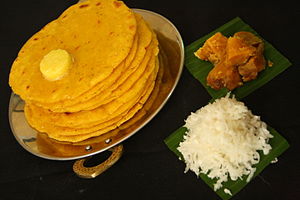Makki ki roti
 Makki ki roti | |
| Alternative names | Makyachi Bhaakri in Marathi,
Mokkajonna Rottelu in Telugu, Makai No Rotlo in Gujarati[1] |
|---|---|
| Type | Bread |
| Place of origin | Indian subcontinent |
| Region or state | Jammu, Himachal Pradesh, Punjab, Haryana, Rajasthan, Gujarat, Uttarakhand, and Uttar Pradesh |
| Main ingredients | Corn flour |
Makki ki roti is a flat unleavened bread made from corn meal (maize flour),[2] primarily eaten in the Jammu region, Himachal Pradesh, Punjab, and in Haryana, Rajasthan, Gujarat, Uttar Pradesh, and Uttarakhand in North India. Like most rotis in the Indian subcontinent, it is baked on a tava.
Etymology
Literally, makkī kī roṭṭī means 'flatbread of maize'.[3][4] The word Makki is derived from Sanskrit Markaka [3] and Roti from Sanskrit word Rotīka. Makki ki roti is yellow in color when ready, and has much less cohesive strength, which makes it difficult to handle.
Mode of serving
Although Makki ki Roti is cooked almost all over India, in media it is often presented as a signifier of Punjabi cuisine.[5] However as per Vir Sanghavi, maize was introduced into only recently after British annexation of Punjab in 1850s.[6] While maize, a New World crop, was introduced to the Indian subcontinent in the 16th century by the Portuguese.
Makki ki roti is generally made during winter and is often accompanied with saag (especially sarson ka saag or channa ka saag). In Himachal it is also eaten with Maah (Urad) daal.[7] Among Dogras there are folk songs talking of Makki di roti like: "मक्के दी रोटी मोइये , सरेआं दा साग हो , पिप्पल मरोड़ी मरोड़ी करी खाना हो ।"[8] Maize food items are also popular in Rajasthan and one of that is maize roti.[9] In fact, maize is one of the staple diet of Bishnois of Rajasthan and Haryana.[10][11] In Uttar Pradesh, maize roti is also eaten with ghee, butter, jaggery and pickles. In Gujarat, this dish is also known as "Makai No Rotlo".
See also
References
- ^ Thaker, Aruna; Barton, Arlene (2012-04-05). Multicultural Handbook of Food, Nutrition and Dietetics. John Wiley & Sons. ISBN 978-1-118-35046-1.
- ^ Jaffrey, M. (2014). Madhur Jaffrey's World Vegetarian: More Than 650 Meatless Recipes from Around the World. Potter/TenSpeed/Harmony. pp. 797–799. ISBN 978-0-307-81612-2.
- ^ a b Turner, Ralph Lilley (1966). A Comparative Dictionary of Indo-Aryan languages. London: Oxford University Press. p. 568.
- ^ Bahri, Hardev (1969). Br̥hat Aṅgrejī-Hindī Kośa (in Hindi). Jn̄anamaṇḍala.
- ^ Andreescu, Raluca; Dimitriu, Anda (2021). Handbook of Research on Contemporary Storytelling Methods Across New Media and Disciplines. IGI Global. p. 195. ISBN 9781799866077.
Media representation of popular signifiers of the food culture of Punjab like Makki di Roti, Sarson de Saag, and Tandoori Chicken enables the food to emerge as a commodity, which also meditates a particular taste besides cultural notions defining "Punjabi." Representation of Punjabi cuisine in media has made the culture and society of Punjab 'spectacular,'-- organized by spectacles (as seen in cookbooks and cinema) of "Punjabi."
- ^ Sanghvi, Vir (2018), I wish we would give besan another chance
- ^ India, Anthropological Survey of (1996). Himachal Pradesh. Anthropological Survey of India. ISBN 978-81-7304-094-8.
- ^ Śāstrī, Rāmanātha; Mohana, Madana; Langeh, Baldev Singh (1970). (Rajata jayantī abhinandana grantha) (in Hindi). Ḍogarī Saṃsthā.
- ^ Cūṇḍāvata, Lakshmīkumārī; Swarankar, Ramesh Chand (2002). Rajasthan Ke Reeti Rivaz (in Hindi). Pablikeśana Skīma. ISBN 9788186782828.
- ^ Singh, K. S. (1998). Rajasthan. Popular Prakashan. ISBN 978-81-7154-766-1.
- ^ Haryana District Gazetteers: Karnal district gazetteer, 1883-84. Gazetteers Organisation, Revenue Department, Haryana. 1998.
Further reading
- "This winter, Makki ki Roti is out of reach". NDTV. November 21, 2009. Retrieved May 5, 2015.
- "Winter recipe: Sarson da saag, makki di roti". The Times of India. January 17, 2015. Retrieved May 5, 2015.
- Marwaha, P. (23 October 2012). Shakahaari (in Dutch). Xlibris Corporation. p. 149. ISBN 978-1-4771-7170-7.[self-published source]
- CS1 Hindi-language sources (hi)
- Articles with short description
- CS1 Dutch-language sources (nl)
- All articles with self-published sources
- Articles with self-published sources from January 2018
- Indian breads
- Indian cuisine
- Pakistani breads
- Flatbreads
- Unleavened breads
- Maize dishes
- Roti
- Punjabi cuisine
- All stub articles
- Indian cuisine stubs
- Pakistani cuisine stubs




